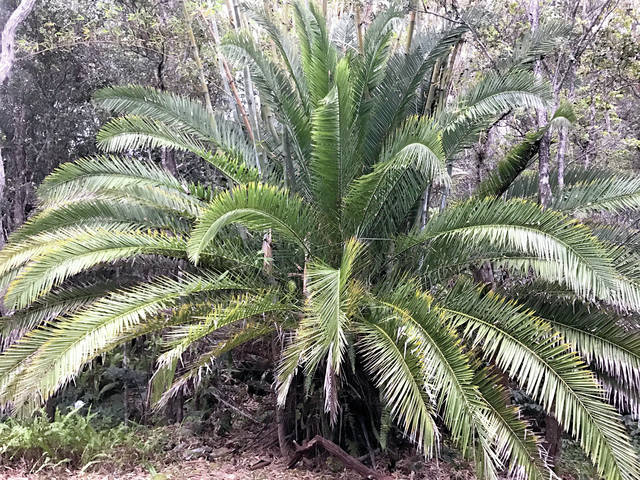During the next several weeks, we are visiting England and Scotland and have been surprised by the use of tropical-looking plants in many gardens. Even though the winter climate can be quite chilly by Hawaii standards, some gardens appear to be almost tropical.
We are seeing windmill palms, or Tracycarpus fortunei, as far north as Edinburgh, Scotland. There also are Canary Island date palms in London. Of course, having the famous Kew Gardens nearby has given folks in southern England access to many subtropical species.
We even ran across a nursery called the Palm Center in south London. It was founded by Martin Gibbons, a well-known horticulturist and International Palm Society member. The nursery carried more than 20 species of palms. Some — such as the Chilean wine palm, butias, sabals and chamaerops — are famous for their hardiness.
The biggest surprise was finding the hardy bamboo palm, Chamaerops microspadix, grown in the area. This delicate shade lover can tolerate temperatures of at least 23 degrees.
Some gardens of the British Isles are great examples of how a semi-tropical look can be achieved in a climate that is chilly much of the winter. The natural vegetation of the region is much like parts of Switzerland or France, but with the use of palms, gardens have a whole different ambiance.
This type of landscaping gives a sort of well-maintained jungle effect. Examples of this can be seen along the Italian and French rivieras, Switzerland’s Lake Geneva and Italy’s lakes Como and Maggiore.
Many visitors to Hawaii wish they could take a bit of the tropics home with them. This actually is possible, since the relaxed tropical look can be achieved almost anywhere. But to develop that tropical look in cooler climates, the selection of materials should be those with a bold and colorful tropical presence.
Here are some tips for your mainland friends who want a touch of the tropics at home.
Trees such as Albizia julibrissin, or Persian silk tree, are very tropical in appearance, with its poinciana-like foliage and pink pompon-like flowers. This tree will tolerate conditions almost to zero degrees. The silk tree is native to Asia and can reach heights of up to 30 feet but usually is much smaller, spreading like an umbrella to 20 feet. The tree’s filtered shade allows grass and other plants to grow underneath. It also makes a very good patio tree.
Of course, a tropical-looking garden must have palms, ferns and even bananas. Many British gardens achieved this look. Two species of hardy banana, Musa basjoo and Musa sikkimensis, can be grown in cool climates such as Seattle and even Germany. If you live in an area where temperatures seldom reach 10 degrees or colder, the Trachycarpus fortunei, or windmill palm, is a great one for the ultra-tropical look. It is relatively fast-growing to about 30 feet. This palm should be used in groups of three to seven for a dramatic effect. The many healthy specimens in Scotland attest to this tree’s ability to withstand cold.
Another palm grown in protected British gardens is the European fan palm, Chamaerops humilis. Plants from New Zealand such as Cordyline australis, tree ferns and New Zealand flax are not uncommon.
Many tropical-looking plants thrive in the summer but freeze to the ground in winter. Hostas, cannnas and callas are examples. Some gingers such as the guava jelly ginger, Hedychium greenei, from the Himalayas can be grown as far north as Edinburgh.
We have seen several hardy bamboos that will take temperatures to zero. One of my favorites is Phyllostachys vivax from China that will reach 70 feet tall. This is a running species and must be given plenty of room. Many Phyllostachys species are hardy much farther north in Scotland.
For smaller gardens, there are many hardy well-mannered clumping species. Close relatives of bamboo such as the Arundo donax, or Spanish cane, from the Mediterranean are used in areas where temperatures are below zero. Although this giant reed might freeze down in winter, given a protective mulch with a good rich soil, it will grow from 6-15 feet in a summer.
Another popular bamboo relative we saw is Pampas grass, or Cortaderia selloana, from Brazil and Argentina. This versatile clumping grass will tolerate dry to wet soils and temperatures close to zero if protected by mulching.
The list of tropical-looking plants goes on and on. We also have seen the hardy eucalyptus species. These include the cider gum and snow gum that survive temperatures close to zero. Fruits such as fig, pomegranate, olive and loquat are found growing around London. Locals swear the climate was much colder before World War II. We even saw a large flock of rose-ringed parakeets one day.
We can learn a lot from our European friends. They have had access to many subtropical plants as the result of the early days of plant exploration and introductions. Our mainland friends can experiment with these and other tropical-looking plants that nurseries and garden centers carry in their area or try some from more southerly locations.
To avoid discouragement, check with garden books that cover plant hardiness. Sunset’s new “Western Garden Book” has some great ideas for plants to try.
Even the cooler climates of Washington state and British Columbia might one day have that tropical Hawaii ambiance, especially with the influence of global warming.



